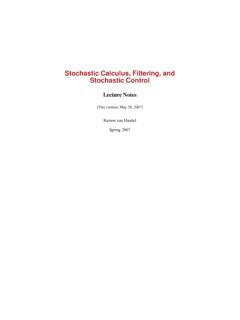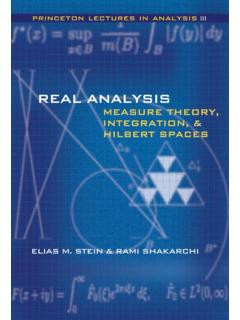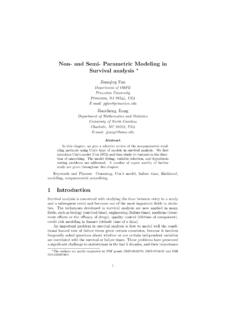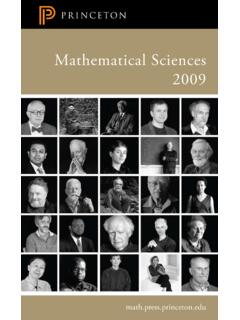Transcription of LECTURE NOTES IN ANALYSIS (2011) Sergiu Klainerman
1 LECTURE NOTES IN ANALYSIS ( 2011 ) Sergiu KlainermanDepartment of Mathematics, princeton University, princeton NJ 08544E-mail 1 INTRODUCTION TO PDE1. The world of PDETo start with partial differential equations, just like ordinary differential or integralequations, arefunctional equations. That means that the unknown, or unknowns,we are trying to determine are functions. In the case of partial differential equa-tions (PDE) these functions are to be determined from equations which involve, inaddition to the usual operations of addition and multiplication, partial derivativesof the functions. Below are the most basic examples, (Laplace equation) u= 0(1)where u= 2 x2u+ 2 y2u+ 2 z2u. The other two examples described in the sectionof fundamental mathematical definitions are (Heat Equation) tu+k u= 0,(2) (Wave equation) 2tu+c2 u= 0.(3)In both cases one is asked to find a functionu, depending on the variablest,x,y,z,which verifies the corresponding equations.
2 Observe that both (2) and (3) in-volve the symbol which has the same meaning as in the first equation, that is u= ( 2 x2+ 2 y2+ 2 z2)u= 2 x2u+ 2 y2u+ 2 z2u. In both (2) and (3)k >0 andcare fixed constants (representing the rate of diffusion for the first and the speedof light in the second). It suffices to study to solve the equations for the specialcasesk= 1 andc= 1. Indeed ifu(t,x,y,z) is a solution of (3), for example, thenv(t,x,y,z) =u(t,x/c,y/c,z/c) verifies the same equation withc= 1. Both equa-tions are calledevolution equations, simply because they are supposed to describethe change relative to the time parametertof a particular physical object. Observethat (1) can be interpreted as a particular case of both (3) and (2). Indeed solutionsu=u(t,x,y,z) of either (3) or (2) which are independent oft, tu= 0, verify(1).Here are some further examples of important PDEs: (Schr odinger equation)i tu+k u= 0(4)withu:R R3 C. The equation describes the quantum evolution of a massiveparticle,k=~2m, where~>0 is Planck s constant andmis the mass of theparticle.
3 As with the heat equation, one can normalizek= 1 by a simple change ofvariables. Though the equation is formally very similar to the heat equation, it hasvery different qualitative behavior. It is important to keep in mind when studying1. THE WORLD OF PDE5 PDE s that small changes in the form of an equation can lead to very differentproperties of solutions. (Klein-Gordon equation) 2tu+c2 u (mc2~)2u= 0(5)This is the relativistic counterpart to the Schr odinger equation, the parametermhas the physical interpretation of mass andmc2has the physical interpretation ofrest energy (reflecting Einstein s famous equationE=mc2). One can normalizethe constantscandmc2~to make them both equal 1 by applying a suitable changeof variables to both time and that all three PDE mentioned above satisfy the following simple propertycalled theprinciple of superposition: Ifu1,u2are solutions of an equation so isany linear combination of them 1u1+ 2u2where 1and 2are arbitrary realnumbers.
4 Such equations are called linear. The following equation in the unknownu=u(x,y), is manifestly not linear: (Minimal surfaces x( xu(1 +| xu|2+| yu|2)12)+ y( yu(1 +| xu|2+| yu|2)12)= 0.(6)Here xand yare short hand notations for the partial derivatives xand equations we have encountered so far can be written in the formP[u] = 0,wherePis adifferential operatorapplied tou. A differential operator is simply arule which takes functionsu, defined inRnor an open subset of it, into functionsP[u] by performing the following operations: We can take partial derivatives iu= u xirelative to the variablesx=(x1,x2,..xn) ofRn. One allows also higher partial derivatives ofusuchas the mixed second partials i ju= 2u xi xjor 2i= 2 associated differential operators for (2) isP= t+ and thatof (3) is 2t+ Can add and multiplyuand its partial derivatives between themselves aswell as with given functions of the variablesx. Composition with givenfunctions may also the case of the equation (1) the associated differential operator isP= = 21+ 22+ 23= 3i,j=1eij i jwhereeijis the diagonal 3 3 matrix with entries(1,1,1) corresponding to the euclidean scalar product of vectorsX,YinR3,< X,Y >=X1Y1+X2Y2+X3Y3=3 i,j=1eijXiXj.)
5 (7)6 The associated differential operators for (2), (3) and (4) are, t+ ,P= 2t+ andP=i t+ with variables aret,x1,x2,x3 R1+3. In theparticular case of the wave equation (3) it pays to denote the variabletbyx0. Thewave operator can then be written in the form, = 20+ 21+ 22+ 23=3 , =0m (8)wherem is the diagonal 4 4 matrix with entries ( 1,1,1,1), corresponding tothe Minkowski scalar product inR1+3. This latter scalar product is defined, for 4vectorsX= (X0,X1,X2,X3) andY= (Y0,Y1,Y2,Y3) by,m(X,Y) =3 , =0m X Y = X0Y0+X1Y1+X2Y2+X4Y4(9)The differential operator is called D Alembertian after the name of the Frenchmathematician who has first introduced it in connection to the equation of a vi-brating that the differential operators associated to the equations (1) (4) are alllinear [ u+ v] = P[u] + P[v],for any functionsu,vand real, or complex, numbers , . The following is anothersimple example of a linear differential operatorP[u] =a1(x) 1u+a2(x) 2u(10)wherex= (x1,x2) anda1,a2are given functions ofx.
6 They are called thecoeffi-cientsof the linear operator. An equation of the formP[u] =f,(11)corresponding to a linear differential operatorPand a given functionf=f(x), iscalledlinear-inhomogeneous. Any solutionuof such an equation can be expressedin the formu=u0+vwhereu0is a special solution of (11) andvsolution to thehomogeneous equationP[v] = 0.(12)In the case of the equation (6) the differential operatorPcan be written, relativeto the variablesx1andx2, in the form,P[u] =2 i=1 i(1(1 +| u|2)12 iu),where| u|2= ( 1u)2+ ( 2u)2. ClearlyP[u] is not linear in this case. We callit a nonlinear operator; the corresponding equation (6) is said to be anonlinearequation. An important property of both linear and nonlinear differential operatorsislocality. This means that whenever we applyPto a functionu, which vanishesin some open setD, the resulting functionP[u] also vanish also that our equations (1)-(4) are also translation invariant. This means,in the case (1) for example, that whenever the functionu=u(x) is a solution so1.
7 THE WORLD OF PDE7is the functionuc(x) :=u(Tcx) whereTcis the translationTc(x) =x+c. Onthe other hand the equationP[u] = 0, corresponding to the operatorPdefined by(10) is not, unless the coefficientsa1,a2are constant. Clearly the set of invertibletransformations1T:Rn Rnwhich map any solutionu=u(x), ofP[u] = 0, toanother solutionuT(x) :=u(Tx) form a group, called the invariance group of theequation. The composition of two symmetries is again a symmetry, as is the inverseof a symmetry, and so it is natural to view a collection of symmetries as forming agroup(which is typically a finite or infinite-dimensionalLie group).The Laplace equation (1) is invariant not only with respect to translations but alsorotations, linear transformationsO:R3 R3which preserve the euclideanscalar product (7) in the sense that< OX,OY >=< X,Y >for all vectorsX,Y R3. Similarly the wave equation (3) and Klein-Gordon equation (5) are invariantunder Lorentz transformations, linear transformationsL:R1+3 R1+3whichpreserve the Minkowski scalar product (9), (LX,LY) =m(X,Y).
8 Ourother evolution equations (2) and (4) are clearly invariant under rotations of thespace variablesx= (x1,x2,x3) R3, keepingtfixed. They are also Galileaninvariant, which means, in the particular case of the Schr odinger equation (278),that wheneveru=u(t,x) is a solution so isuv(t,x) =ei(x v)eit|v|2u(t,x vt) forany vectorv far we have tacitly assumed that our equations take place in the whole space R3for the Laplace equation,R4for the Heat, Wave and Schr odinger equations andR2for the minimal surface equation. In reality, one is often restricted to a domainof the corresponding space. Thus, for example, the equation (1) is usually studiedon a bounded open domain ofR3subject to a specifiedboundary condition. Hereis a typical Dirichlet problem on an open domain ofD R3consists offinding a continuous functionsudefined on the closure DofD, twice continuouslydifferentiable inD, such that u= 0 inDand the restriction ofuto D, theboundary ofD, is prescribed to be a continuous functionu0.
9 More precisely werequire that,u| D=u0(13)One can impose the same boundary condition for solutions of (6), withDa boundedopen domain ofR2. A solutionu=u(x,y) of (6) inD, verifying the boundarycondition (13), solves the Plateau problem of finding minimal surfaces inR3whichpass through a given curve. One can show that the surface given by the graph u={(x,y,u(x,y))/(x,y) D R2}has minimum area among all other graphsurfaces vverifying the same boundary condition,v| D= boundary conditions can also be imposed for the evolution equations (2) (4). The simplest one is to prescribe the values ofuon the hyperplanet= 0. Inthe case of the heat and Schr odinger equation we set,u|t=0=u01 The transformations are often linear in the case of the wave equation, which involves a second derivative int, weimpose two conditionsu|t=0=u0and tu|t=0=u1(14)whereu0,u1are functions of the coordinates (x,y,z), calledinitial conditions. Tosolve theinitial value problemin both cases means to find solutions of the equationsfort >0 which verify the corresponding initial conditions att= 0.
10 In additionone may restrict the variables (x,y,z) to an open domain ofD R3. More to thepoint one may try to solve a boundary value problem in a domain [0, ) Dwith aboundary condition, such as (13), on [0, ) Dand an initial condition att= choice of boundary condition and initial conditions, for a given PDE, is veryimportant. Finding which are the good boundary and initial conditions is an im-portant aspect of the general theory of PDE which we shall address in section equations of physical interest these appear naturally from the context in whichthey are derived. For example, in the case of a vibrating string, which is describedby solutions of the one dimensional wave equation 2tu 2xu= 0 in the domain(a,b) R, the initial conditionsu=u0, tu=u1att=t0, amount to specifyingthe original position and velocity of the string. On the other hand the boundaryconditionu(a) =u(b) = 0 simply mean that the two ends of the of the string far we have only considered equations inone unknown.]]















